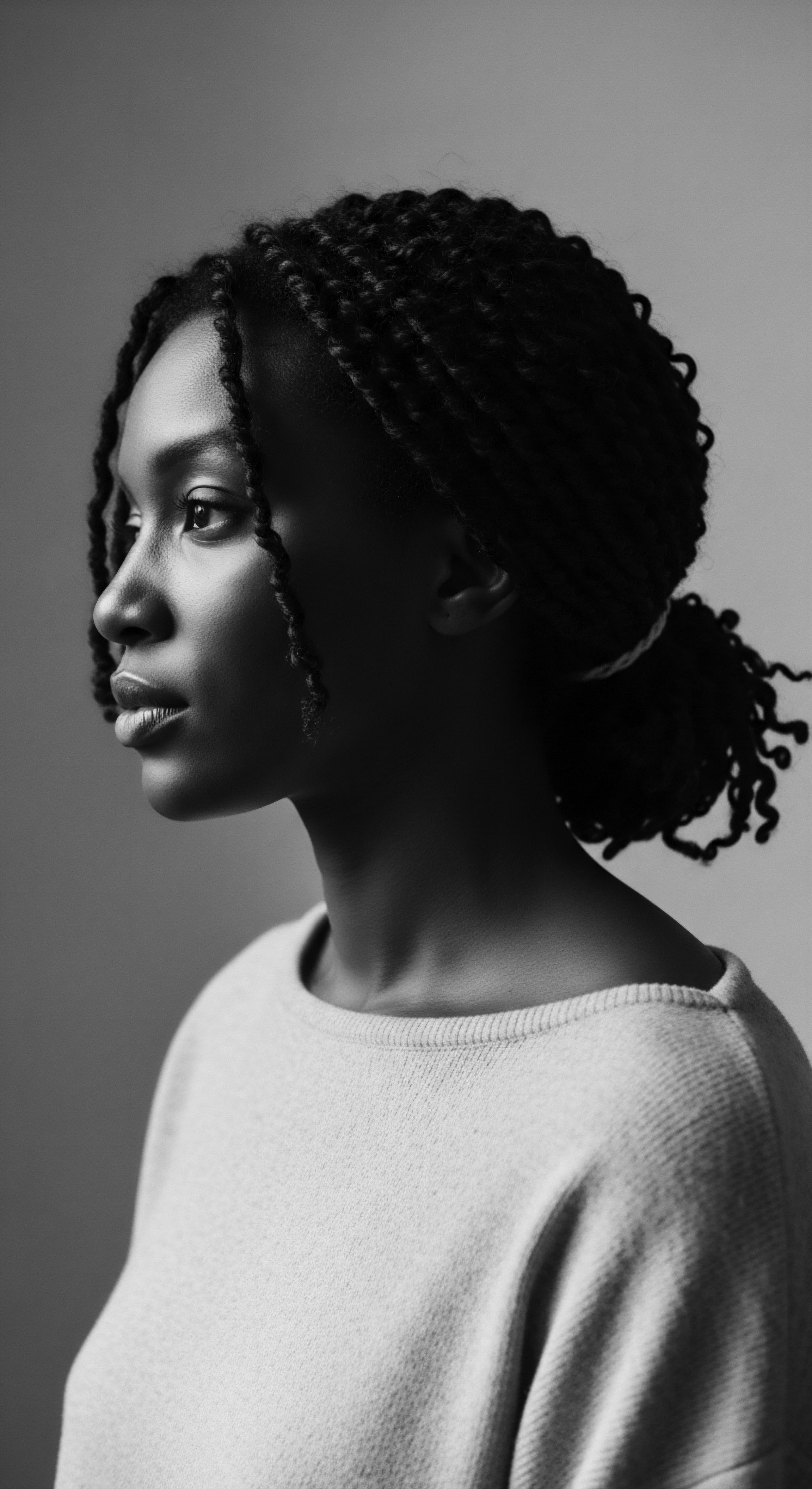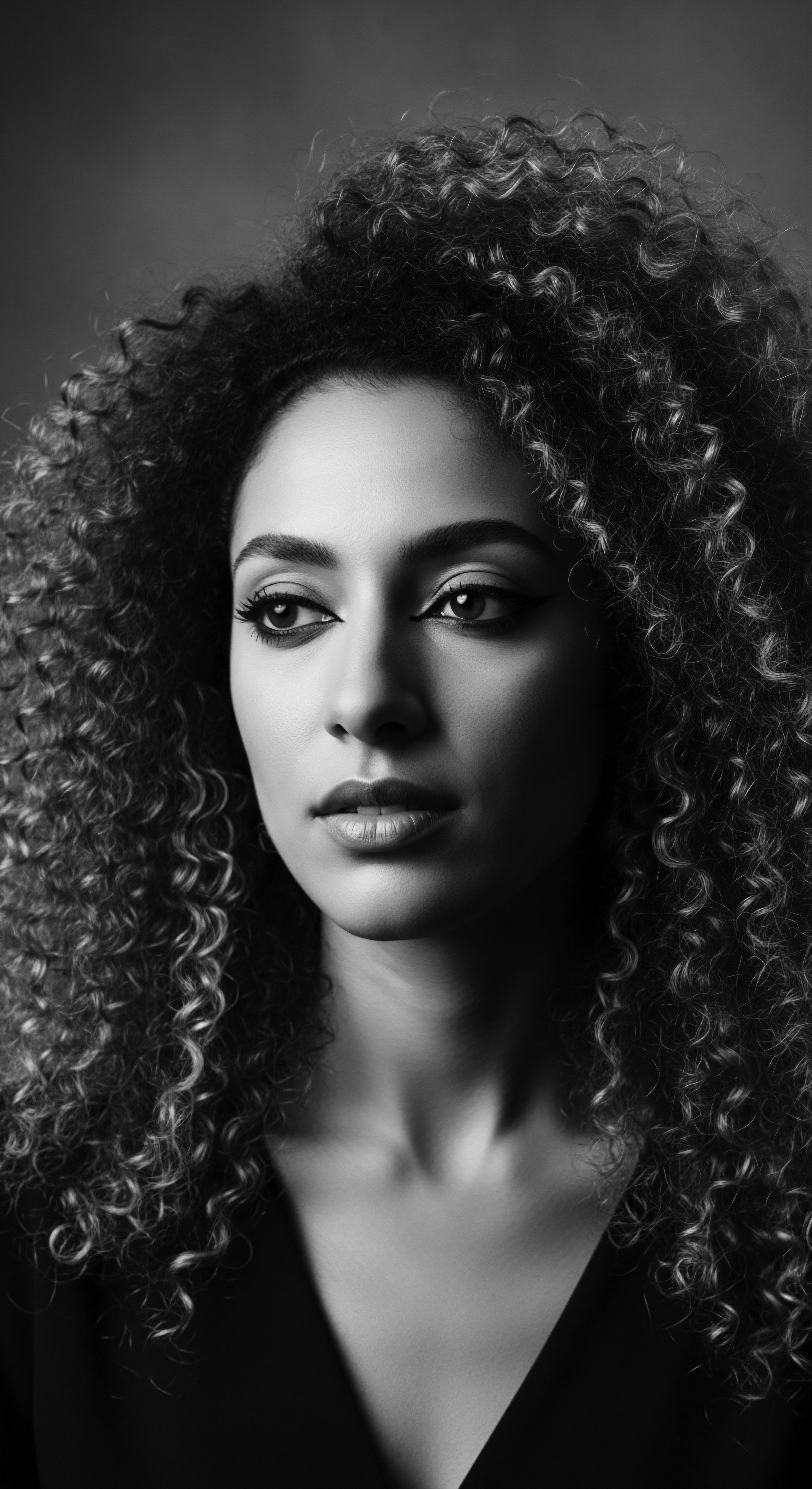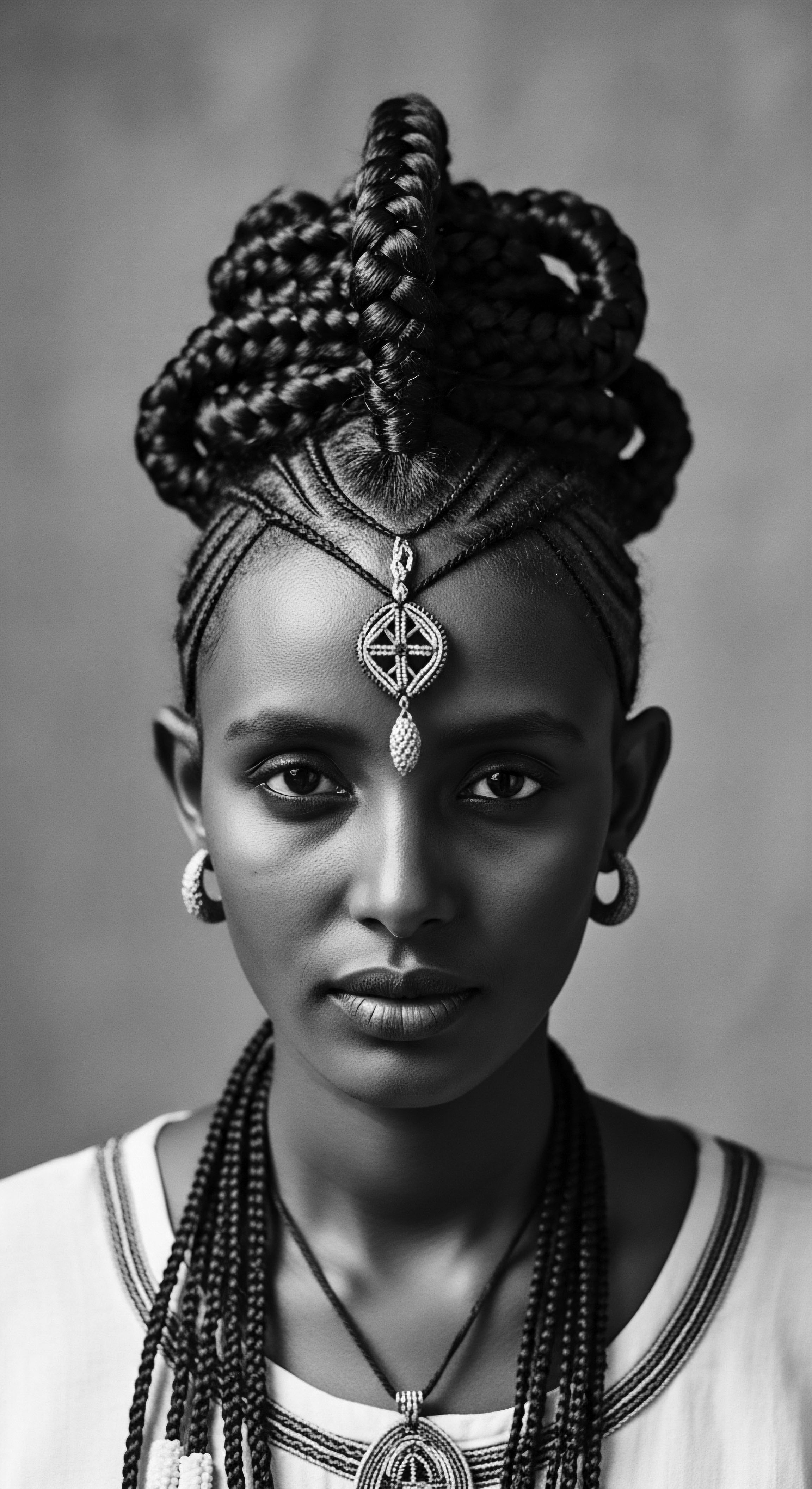
Fundamentals
The Sun Defense, within the cherished archives of Roothea’s living library, represents the inherent and acquired capacities of hair, particularly textured strands, to withstand the radiant energy of the sun. This explanation goes beyond mere contemporary product application; it encompasses a deep historical understanding of how various communities, especially those with ancestral ties to sun-drenched lands, have honored and protected their hair from solar exposure. The concept of Sun Defense, in its simplest rendering, speaks to the hair’s ability to resist damage from ultraviolet (UV) radiation, which can compromise protein structures, deplete moisture, and alter pigment.
For textured hair, with its unique coil patterns and often higher porosity, this protective capacity holds distinct significance. The very architecture of a coily strand, with its twists and turns, presents a different surface area to the sun compared to straight hair. Historically, human ingenuity paired with deep reverence for natural elements provided early solutions. These solutions were not formulated in laboratories but rather distilled from generations of observation, communal knowledge, and an intimate connection to the earth’s offerings.
Sun Defense for textured hair is a foundational concept rooted in ancestral wisdom and the inherent resilience of diverse hair forms.

Early Understandings of Solar Protection
Across various traditional societies, particularly in regions with intense sun exposure, practices emerged to shield hair and scalp. These were often interwoven with daily rituals, cosmetic applications, and cultural identity. The recognition that prolonged sun exposure could lead to dryness, brittleness, and a fading of natural hair color was not a scientific discovery of recent times; it was an observable truth passed down through generations. Our ancestors, keenly attuned to their environments, discerned the elements that offered succor.
The meaning of Sun Defense, at its core, is the preservation of hair’s vitality against environmental stressors. This designation extends to the use of natural oils, plant extracts, and physical coverings, all designed to maintain the integrity and health of the hair. These early methods underscore a profound connection to the land and its resources, where plants were not just sustenance but also potent allies in self-care.
- Natural Oils ❉ Many traditional communities utilized plant-derived oils, such as shea butter or coconut oil, as topical applications. These oils formed a physical barrier, helping to seal in moisture and potentially scatter some UV rays.
- Plant Pigments ❉ Certain plant materials, when applied to hair, offered natural dyes that might have also contributed to a minor degree of light absorption, offering a subtle shield.
- Physical Coverings ❉ Headwraps, turbans, and elaborate hairstyles served not only as markers of status or cultural identity but also as practical means to cover and protect the hair and scalp from direct sun.

Intermediate
Moving beyond initial observations, the Sun Defense concept deepens when considering the intrinsic biological mechanisms within textured hair and the sophisticated practices developed to augment these natural capabilities. The very pigmentation of hair, primarily melanin, offers a degree of natural protection against ultraviolet radiation. Eumelanin, the dominant melanin type in darker hair, is particularly adept at absorbing and scattering UV light, acting as an internal shield. This inherent characteristic suggests an evolutionary adaptation for populations originating in sun-rich equatorial zones.
However, even with melanin’s protective attributes, prolonged exposure to intense solar radiation can still degrade hair proteins, especially keratin, leading to diminished elasticity and increased susceptibility to breakage. The sun’s energy also compromises the lipid layer surrounding the hair cuticle, accelerating moisture loss. This interplay between natural resilience and environmental challenge necessitated further human intervention, leading to the development of time-honored hair care regimens. The clarification of Sun Defense at this level involves recognizing both the biological endowments and the ancestral wisdom that sought to bolster them.
Hair’s natural melanin provides an initial solar shield, a biological legacy from sun-drenched ancestries, yet historical care practices fortified this defense.

Ancestral Care and Environmental Adaptation
The practices of Sun Defense among communities with textured hair were not random acts but rather carefully refined traditions, passed through oral histories and lived experiences. These rituals often reflected an acute understanding of the local climate, the availability of natural resources, and the specific needs of coily, kinky, and wavy hair types. The collective understanding of hair’s susceptibility to the elements led to preventive measures, signifying a communal investment in hair health and appearance.
Consider the use of shea butter (Vitellaria paradoxa), a staple across West African communities. This botanical lipid, extracted from the nuts of the shea tree, was and remains a cornerstone of skin and hair care. Its rich composition, including fatty acids, vitamins, and unsaponifiable compounds, allowed it to serve multiple purposes. Applied to hair, shea butter provided a substantive emollient layer, sealing the cuticle, reducing water evaporation, and providing a physical barrier against solar rays.
This traditional application illustrates a practical understanding of hair’s physical needs in harsh environments. Akerele (1991) discusses the traditional uses and properties of shea butter, including its long-standing role in skin and hair protection.
| Ancestral Ingredient/Practice Shea Butter (Vitellaria paradoxa) |
| Traditional Application Applied as a protective balm to hair and scalp, especially before sun exposure. |
| Contemporary Understanding/Benefit Forms a physical barrier, offers emollients, and contains minor UV-absorbing compounds. |
| Ancestral Ingredient/Practice Red Ochre Paste (e.g. Otjize of Himba) |
| Traditional Application Mixed with butterfat, applied to hair and skin for cosmetic and protective reasons. |
| Contemporary Understanding/Benefit Provides a physical shield against solar radiation, offers moisture retention. |
| Ancestral Ingredient/Practice Plant-Based Rinses |
| Traditional Application Infusions from certain leaves or barks used to rinse hair. |
| Contemporary Understanding/Benefit Could offer mild astringent, conditioning, or antioxidant properties that support hair integrity. |
| Ancestral Ingredient/Practice These ancestral approaches to hair care reveal an intuitive knowledge of botanical properties and environmental adaptation. |

The Sun’s Influence on Hair Structure
The solar spectrum contains various wavelengths, with UVA and UVB being particularly relevant to hair. UVB rays are shorter and more energetic, capable of directly damaging the hair’s protein structure and melanin. UVA rays, longer and less energetic, still contribute to oxidative stress, leading to color fading and overall weakening of the hair shaft.
For textured hair, which often has a more irregular cuticle layer compared to straight hair, this damage can manifest as increased frizz, dryness, and a greater propensity for tangling and breakage. The interpretation of Sun Defense, then, extends to understanding these specific vulnerabilities.
Understanding how sun exposure affects the delicate balance of moisture and protein within the hair strand highlights the ingenuity of ancestral practices. They sought to fortify the hair’s outer layer and replenish its internal moisture, countering the drying and degrading effects of solar radiation. This deep knowledge, born from centuries of observation and adaptation, represents a significant cultural inheritance in hair care.

Academic
The academic elucidation of Sun Defense for textured hair requires a comprehensive examination, integrating biophysical principles with ethno-historical contexts and the socio-cultural ramifications of hair care traditions. This sophisticated delineation moves beyond a simplistic understanding of protection, addressing the intricate interplay of melanin photoprotection, structural vulnerabilities inherent to diverse hair morphologies, and the profound cultural significance of protective practices across the African diaspora. The meaning of Sun Defense, in this scholarly light, represents a complex adaptive system, where biological endowment meets generations of human ingenuity in the face of environmental stressors.
At a microscopic level, human hair, particularly that with higher concentrations of eumelanin, possesses an inherent capacity to absorb and neutralize a portion of incoming ultraviolet radiation. Eumelanin’s conjugated double bonds enable it to dissipate absorbed UV energy as heat, minimizing the formation of damaging free radicals within the hair shaft. Despite this internal shield, prolonged and intense solar exposure can still initiate photo-oxidative degradation of the hair’s keratinous proteins, particularly the disulfide bonds that contribute significantly to hair strength and elasticity. This degradation leads to increased porosity, reduced tensile strength, and color alteration.
The unique helical and coiled structures of textured hair, characterized by multiple twists and bends, can also present varying surface exposures to incident sunlight, potentially concentrating degradation at points of curvature or stress. Robbins (2012) offers detailed insights into the chemical and physical behavior of human hair, including its response to environmental factors like solar radiation.
The academic definition of Sun Defense for textured hair merges biological resilience with cultural adaptation, forming a complex interplay of natural and traditional protections.

Echoes from the Source ❉ Ancestral Knowledge Systems
The deep history of Sun Defense practices in African and diasporic communities offers a compelling counterpoint to modern scientific inquiry, often providing empirical validation for ancestral wisdom. These practices were not accidental but the result of iterative observation and refinement over millennia. For instance, the Himba people of Namibia have long applied a mixture of otjize , a paste made from red ochre and butterfat, to their hair and skin. This practice serves not only as a cosmetic and cultural marker but also as a remarkably effective form of solar protection.
Kandjii (2014) explores the cultural significance of otjize in Himba women’s lives, highlighting its multifaceted role. The red ochre, rich in iron oxides, physically blocks a significant portion of UV radiation, while the butterfat provides an occlusive layer that seals in moisture, counteracting the drying effects of the desert sun. This historical example underscores a sophisticated, albeit empirically derived, understanding of photoprotection and moisture retention, directly addressing the vulnerabilities of textured hair in arid, high-UV environments.
The systematic application of plant-based oils and butters, common across various African societies, also speaks to this ancestral comprehension. Beyond their emollient properties, many of these natural ingredients possess inherent antioxidant compounds that help neutralize free radicals generated by UV exposure, further mitigating oxidative stress on the hair. The explication of Sun Defense thus requires acknowledging these deep-seated traditions as legitimate knowledge systems.

The Tender Thread ❉ Community and Care
The communal aspect of hair care within Black and mixed-race communities traditionally reinforced Sun Defense practices. Hair dressing was often a shared activity, a moment for intergenerational transmission of knowledge, stories, and techniques. Grandmothers, mothers, and aunties passed down methods of preparing protective salves, braiding hair into styles that minimized exposure, and understanding the subtle cues of hair in need of restoration.
This collective care ensured that practices were not only preserved but also adapted to specific environmental conditions and hair textures within families and communities. The designation of hair as a site of shared cultural heritage meant its protection was a collective responsibility.
This community-centered approach contrasts sharply with the individualized focus of much modern cosmetic science. The ancestral understanding of Sun Defense was embedded within a broader philosophy of holistic wellbeing, where hair health was inextricably linked to spiritual, social, and environmental harmony. The significance of these rituals extended beyond mere physical protection; they were acts of cultural affirmation and resilience. Byrd and Tharps (2014) offer a comprehensive historical account of Black hair in America, illustrating how hair care has always been intertwined with identity and community.
| Aspect Primary Agents |
| Ancestral Sun Defense Natural oils, butters, plant extracts, clays, physical coverings. |
| Modern Sun Defense Synthetic UV filters (e.g. octinoxate, avobenzone), silicone-based compounds, specialized polymers. |
| Aspect Application Method |
| Ancestral Sun Defense Topical application, massage, braiding, styling for coverage, communal rituals. |
| Modern Sun Defense Sprays, creams, leave-in conditioners, often with a focus on ease of application. |
| Aspect Knowledge Transmission |
| Ancestral Sun Defense Oral tradition, intergenerational teaching, lived experience, community practice. |
| Modern Sun Defense Scientific research, product development, marketing, consumer education. |
| Aspect Underlying Philosophy |
| Ancestral Sun Defense Holistic wellbeing, environmental harmony, cultural identity, communal responsibility. |
| Modern Sun Defense Cosmetic enhancement, damage prevention, scientific efficacy, individual consumer choice. |
| Aspect Both systems aim to protect hair, but ancestral methods are deeply rooted in cultural context and communal knowledge. |

The Unbound Helix ❉ Voicing Identity and Shaping Futures
The Sun Defense of textured hair is not merely a biological or historical fact; it remains a living practice that continues to shape identity and future care strategies. For individuals with Black and mixed-race hair, the choice of protective styles and products often carries layers of personal and collective meaning, connecting them to a lineage of resilience and self-preservation. The continuous search for effective, culturally relevant Sun Defense solutions speaks to an ongoing dialogue between ancient wisdom and contemporary scientific discovery. This ongoing conversation shapes how textured hair is perceived, cared for, and celebrated globally.
The clarification of Sun Defense also extends to understanding its implications for product development and consumer education. Recognizing the unique needs of textured hair under solar stress necessitates formulations that honor its delicate protein-lipid balance and structural specificities. This includes ingredients that offer broad-spectrum UV protection, humectants to attract and retain moisture, and emollients to seal the cuticle.
Moreover, promoting protective styling, such as braids, twists, and covered styles, continues the legacy of ancestral practices, providing a practical and culturally affirming avenue for Sun Defense. The interpretation of this concept must therefore be dynamic, acknowledging its historical roots while adapting to contemporary challenges and opportunities in textured hair care.
- Hair Melanin ❉ Eumelanin in darker hair provides natural UV absorption and dissipation, reducing direct damage.
- Cuticle Integrity ❉ Sun exposure degrades the hair’s outer cuticle, increasing porosity and moisture loss. Protective measures aim to maintain this barrier.
- Protein Degradation ❉ UV radiation breaks down keratin proteins and disulfide bonds, compromising hair strength and elasticity.
- Oxidative Stress ❉ Solar energy generates free radicals, leading to oxidative damage to hair lipids and proteins. Antioxidants in natural ingredients can counteract this.
The ongoing relevance of Sun Defense for textured hair underscores a profound connection to environmental adaptation and cultural continuity. It represents a continuous dialogue between inherited resilience and intentional care, a testament to the enduring wisdom embedded within Black and mixed-race hair traditions.

Reflection on the Heritage of Sun Defense
As we draw this contemplation to a close, the concept of Sun Defense, as enshrined within Roothea’s living library, stands as a testament to more than mere scientific principle; it embodies a profound cultural inheritance. It is a story whispered across generations, etched into the very strands of textured hair, a story of survival, ingenuity, and beauty born from an intimate relationship with the sun. The meaning of Sun Defense extends far beyond topical application; it is a declaration of reverence for the natural world and a deep respect for the wisdom of those who came before.
The enduring legacy of Sun Defense practices, from the ochre-infused coils of the Himba to the meticulously oiled braids of countless African and diasporic communities, speaks to a continuous thread of care. This thread binds us to our ancestors, reminding us that the quest for hair health is not a modern invention but an ancient pursuit, deeply intertwined with identity and resilience. The resilience of textured hair, often misunderstood or devalued in dominant beauty narratives, finds its strength not only in its unique biological structure but also in the ancestral practices that have shielded and celebrated it through the ages.
The heritage of Sun Defense for textured hair is a vibrant, continuous narrative of ancestral wisdom, resilience, and an enduring connection to the earth’s protective gifts.
This continuous dialogue between elemental biology and human innovation invites us to look upon textured hair not simply as a cosmetic attribute but as a living archive. Each coil, each twist, each strand carries the echoes of environments faced, solutions found, and traditions upheld. Understanding Sun Defense through this lens allows us to appreciate the enduring wisdom that protected our hair from the sun’s gaze, ensuring its vitality and preserving its stories. It reminds us that care is a language of love, spoken through generations, ensuring the legacy of a strand remains unbound, radiant, and deeply rooted in its ancestral soil.

References
- Akerele, O. (1991). Shea butter ❉ a review. International Journal of Crude Drug Research, 29(4), 293-301.
- Byrd, A. D. & Tharps, L. L. (2014). Hair Story ❉ Untangling the Roots of Black Hair in America. St. Martin’s Press.
- Ezeji, C. (2015). The Cultural Politics of Hair in the African Diaspora. Routledge.
- Hunter, T. L. (2011). African American Hair ❉ An Ethnographic Perspective. University Press of Mississippi.
- Kandjii, T. (2014). The cultural significance of otjize in Himba women’s lives. University of Namibia.
- Okereke, C. (2017). Hair and the African Woman ❉ A Cultural History. University of Michigan Press.
- Robbins, C. R. (2012). Chemical and Physical Behavior of Human Hair. Springer.
